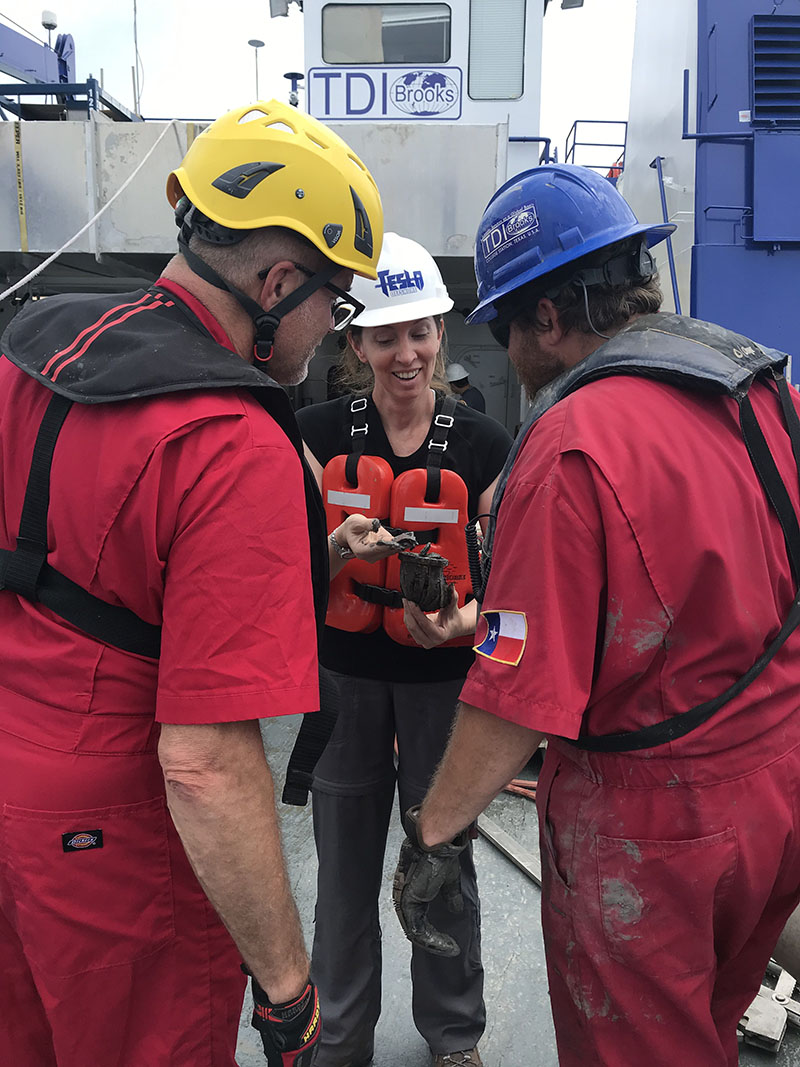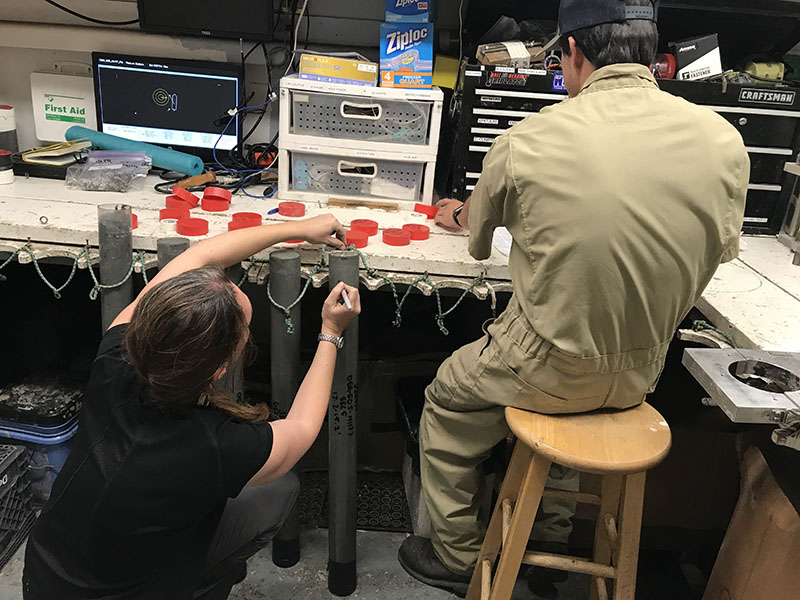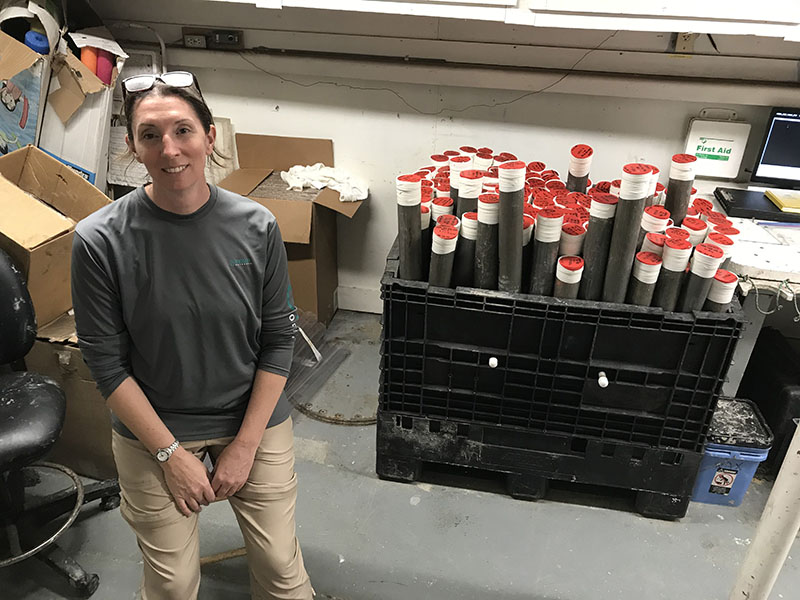
By Alexandra Herrera-Schneider, Archaeological Field Technician, Coastal Environments, Inc.
October 9, 2020
The opportunity to work with Dr. Amanda Evans on the reconstruction of paleolandscapes in the Gulf of Mexico has been such an unbelievable learning experience. Not only was it an honor to work alongside such an admirable and competent legend of a scientist on her pet project, but I was also pursuing knowledge on maritime cultural landscapes in a relatively new discipline.
This expedition was my second trip for this project and I naively thought that I was more prepared this time around than my first expedition in 2019. That was, until I felt my heartstrings strum rapidly each and every time the piston coring rig was deployed over the stern of the ship, not knowing what to expect when it came back up.
There was always a rush of wonder as we waited very patiently for the piston core to reemerge with our mud samples. Once the rig was back on-deck, we carefully examined and labeled each core. We had to exercise extreme self-control not to pick through the core cross-sections while dividing the core samples to properly package them for later analysis onshore. After packaging was finished, for each core sample , we had a little lump of mud leftover. With great satisfaction, we physically mashed through each leftover lump to make sure it was clear of any artifacts before being discarded. The whole process was quick, taking an average of 20 minutes.
Time-lapse of the whole process. The entire process took about 20 minutes. Video courtesy of A. Herrera-Schneider, Paleolandscapes and the ca. 8,000 BP Shoreline of the Gulf of Mexico Outer Continental Shelf 2020. Download larger version (mp4, 253 MB).

Dr. Amanda Evans excitedly showing the party chief and crew exciting finds. Image courtesy of A. Herrera-Schneider, Paleolandscapes and the ca. 8,000 BP Shoreline of the Gulf of Mexico Outer Continental Shelf 2020. Download larger version (jpg, 3.5 MB).
When we were not collecting samples, I would frequently sit in the survey laboratory with Dr. Evans, watching and learning as she worked and explained all of the different layers involved in her research. I would observe her repeatedly going over her data, fine tuning analyses, adjusting plans, researching fauna, preparing for the next day, and then preparing alternatives.

Dr. Amanda Evans in the ship’s lab writing field notes on each core sample. Image courtesy of A. Herrera-Schneider, Paleolandscapes and the ca. 8,000 BP Shoreline of the Gulf of Mexico Outer Continental Shelf 2020. Download larger version (jpg, 3.7 MB).
It’s interesting to note the current global state in parallel with this exploratory expedition of Paleolandscapes on the Gulf of Mexico’s Outer Continental Shelf. For example, the U.S. Army Corps of Engineer Galveston District is currently conducting a coastal Texas study to build coastal defenses from rising sea levels and coastal storm risk management (The Texas General Land Office, 2020). These concerns about coastal resilience amidst the COVID-19 pandemic brought to light how much I overlooked the reality of being more susceptible to illness and disaster. Similarly, when waters rose and early human populations in the region became displaced, their lives were irrevocably changed. The loose comparison provides insight into the consequences and complications of global change.
Not only did this project, and Dr. Evans provide me with valuable experiences, but I also found a new scientific interest that I cannot wait to investigate and learn all I can. I hope to use that knowledge to conduct research that supports the discovery and exploration of submerged landscapes for both the scientific community and the general public. This expedition has influenced me to grow as a scientist with the background research knowledge needed and the necessary critical thinking to be flexible when the forces don’t go your way while still being productive. But most importantly, the possibilities of research are out there - All the thanks to NOAA and Dr. Amanda Evans.
The grad school application process has started, and I have enormous footsteps to follow!
Thank you, Dr. Amanda Evans and NOAA!

Dr. Amanda Evans with all of her samples. Image courtesy of A. Herrera-Schneider, Paleolandscapes and the ca. 8,000 BP Shoreline of the Gulf of Mexico Outer Continental Shelf 2020. Download larger version (jpg, 3.2 MB).
2020 The Need for the Coastal Texas Study. The Texas General Land Office.
https://coastalstudy.texas.gov/about-the-study/the-threat/index.html, accessed June 24, 2020.
Evans, A. M., and M. E. Keith
2011 Benefit Analysis of a Maritime Cultural Landscape Approach to Submerged Prehistoric Resources, Northwestern Gulf of Mexico. In: The Archaeology of Maritime Landscapes, edited by B. Ford, pp. 169-178. Springer Publishing, New York.
Wyatt, B. and D. Dietrich-Smith (editors)
2017 Proceedings of the Maritime Cultural Landscape Symposium, October 14-15, 2015, University of Madison-Wisconsin. National Center for Preservation Technology and Training, National Park Service, U.S. Department of the Interior, Washington, D.C.